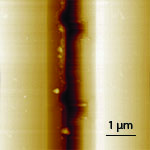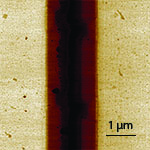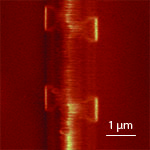產品介紹
-
-
NTEGRA Nano IR
Ultralow drift advanced AFM-IR & s-SNOM imaging and spectroscopy
產品說明
| > AFM IR s-SNOM microscopy and spectroscopy with 10 nm spatial resolution > Wide spectral range of operation: 3-12 μm > Incredibly low thermal drift and high signal stability > Versatile AFM with advanced modes: SRI (conductivity), KPFM (surface potential), SCM (capacitance), MFM (magnetic properties), PFM (piezoelectric forces) > HybriD ModeTM - quantitative nanomechanical mapping > Integration with microRaman (optional) |
 NTEGRA Nano IR principal scheme
|
|
| NT-MDT Spectrum Instruments presents NTEGRA Nano IR - scattering scanning near-field optical microscope (s-SNOM) designed for infrared (IR) spectral range. AFM IR AFM IR AFM IR AFM probe is located in the focus of optical system which excites sample structure by IR laser and collects the optical response. Collected light is directed to Michelson interferometer for optical analysis. |
Far-field component of the collected signal is suppressed by using lock-in techniques at cantilever oscillation frequencies. NTEGRA Nano IR system allows detection of near-field signal amplitude and phase. Spatial resolution of IR s-SNOM is about 10 nm and defined only by tip size. |
產品應用
Ultrathin films: Oligothiophene monolayers on Silicon
| Topography (left), reflection for λ= 10.6 μm (center) and cross section of reflection signal (right). Sample courtesy to Dr. A. Mourran (DWI, Aachen, Germany). Measured by Dr. G. Andreev (EVS Co) |
||
IR reflection contrast of thin and soft structures easily detectable. Each of five 3.4 nm steps is resolved. Spatial resolution is better than λ/1000.
Phase transition behavior of VO2 film
|
Vanadium dioxide is a natural disordered metamaterial. VO2 film grown on a TiO2 substrate comprises nanoscale islands of metal- and dielectric-phase. Under the heating VO2 film demonstrates phase insulator to metal transition. Same area was measured by s-SNOM at different temperatures. Bright areas show conductive domains and dark areas correspond to dielectric domains. Above critical temperature conductive domains become connected to each other and VO2 film demonstrates conducting properties in macroscale. Due to essential parts of the AFM are made of Ti the instrument demonstrates high stability at temperatures up to 100 0C exhibits extremely low drift: <1 um XY drift for temperature changes from 27 0C to 67 0C. No realignment of NTEGRA Nano IR optics needed. |
|||||
Si-SiO2 calibration grating
|
Another example is a grating in which the square-shaped SiO2pads with lateral dimensions 1.5x1.5 µm and height of ~20 nm are grown on Si surface. The square blocks are well distinguished in IR images by a darker contrast compared to the Si substrate. This contrast reflects the differences between the real components (ε΄) of dielectric permittivity of these materials at 10.6 μm wavelength. The darker contrast of SiO2 pads in s-SNOM map is consistent with lower value of its permittivity (εr = 3.9) compared to that of Si (εr = 11.7). |
|||||
PS/PVAC film on the conducting ITO substrate
 |
 |
 |
||
| Height (left), reflection (center) and absorption (right) images of a PS/PVAC film on ITO substrate | ||||
| The height image of PS/PVAC film on the ITO substrate shows the morphology in which the circular domains of different height are embedded into a relatively flat matrix. Only small contrast changes are noticed on the domains and matrix locations whereas the domains’ edges are seen most pronounced. | The situation is quite different in IR nano-adsorption image in which the high contrast of the circular domains allows their assignment to PVAC - the polymer that has adsorption band near 10.6 μm. These data demonstrate that the spatial resolution of IR reflection and absorption mapping is well beyond the diffraction limit of the applied IR light. |
Thermoplastic vulcanizate (TPV)
 |
 |
|
| Height (left) and IR reflection (right) images of TPV sample | ||
| Thermoplastic vulcanizate (TPV) is a nanocomposite which is made of a blend of isotactic polypropylene and EPDM rubber that are mixed with carbon black particles. Such samples exhibit shiny black surface and, therefore, they are burned in Raman studies. The AFM/IR measurements of this sample are not only possible but they are very successful. | A number of bright nanoparticles seen in a central part of the height image can be assigned to carbon black fillers. The suggestion is strongly supported by the IR reflection image in which the carbon nanoparticles show extremely bright contrast compared to the polymer matrix. |
Si microstructure with p-doping areas
 Sample scheme |
 Topography |
 s-SNOM Amplitude |
 s-SNOM Phase |
| In this sample, the strips of p-doping (p~1020 cm-3) were formed on a Si wafer by a BF2 ion implantation of the substrate surface. To investigate the sample in a cleaved-surface geometry, two strips of a diced sample were glues together before their final polishing. An epoxy which fills the slit between the pieces prevents the tip from being broken by a sample edge. Such a sample was scanned with an s-SNOM at a wavelength of 10.6 μm. |
s-SNOM images clearly demonstrate a contrast between doped and undoped areas of Si. In most, such a contrast is caused by difference in a free carrier concentration in heavily doped and slightly doped Si. Real part (ε΄) of a sample dielectric function is determined mainly by the value εSi=11.7. Without doping, εSi is purely real at CO2 laser wavelengths, because no absorption is known for undoped Si at a wavelength of 1-200 μm. In a doped Si sample, plasma of free carriers adds an imaginary part to εSidielectric function at light frequency, modifying mainly a phase of εSi complex value. |
產品規格
| Lasers and light input system Free space coupling module for easy laser source switching without realignment CO2 laser: TEC cooled, stabilized, software tunable CO2 laser, λ=10.3-10.8 μm with improved laser stability: less than +/-0.25 % variation in 30 min Tunable midIR lasers in the range 4-11 μm with Mode-Hop-Free tuning range 60 cm-1 typically Displacement free attenuators. Transmission level of 0.05, 0.12, 0.2, 0.25, 0.45 s-SNOM imaging and spectroscopy system Piezo-actuated reference mirror with closed-loop controller. Closed-loop interferometer reference arm control (tip/tilt). Enables remote optimization of the interferometer XYZ micrometer linear translation stage and piezo-stage for hot-spot alignment Low noise LN2 cooled MCT detector: <30 nV/√Hz at tapping frequency harmonics (100 kHz – 1 MHz) Modular design: all essential components are replaceable. Includes free space module, detector, beam splitter, focusing, collimating and detector lenses Controlled gas environment and temperature for highest stability and possibility to operate at IR atmospheric absorption bands Visible laser for IR beam tracking and control of optical system alignment |
AFM High-performance low noise AFM: Z-noise <0.05 nm (RMS in 10-1000 Hz bandwidth) 10 nm AFM and s-SNOM spatial resolution Low system drift – titanium head design minimize phase drift between tip and interferometer reference mirror Stable AFM performance at high temperatures: up to 150 0C with standard heating stage XYZ closed-loop sample scanner 100 x 100 x 10 μm Sample approach system. Different sample height does not require optical realignments after sample change Focus track feature: sample always stays in focus due to sample Z-feedback All standard SPM imaging modes are supported (>30 modes including KPFM, SRI, PFM, SCM) — combined with IR s-SNOM Integration with HybriD Mode™ for nanoscale stiffness and adhesion properties investigation Top viewing microscope with 1 μm spatial resolution Software Hot-spot alignment assist: field maps enable finding the absolute maximum of s-SNOM amplitude signal in minutes, with absolute certainty Oscilloscope: real time observation of amplitude and phase signals while aligning Interferometer alignment: software control of reference mirror tip/tilt. Better than 2 μRad precision for both tip and tilt Powerful export to other software (Excel, MatLab etc.) |








